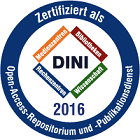Rottmann, Peter: Map Generalization and Set Visualization Through Spatial Unit Allocation. - Bonn, 2025. - Dissertation, Rheinische Friedrich-Wilhelms-Universität Bonn.
Online-Ausgabe in bonndoc: https://nbn-resolving.org/urn:nbn:de:hbz:5-86333
Online-Ausgabe in bonndoc: https://nbn-resolving.org/urn:nbn:de:hbz:5-86333
@phdthesis{handle:20.500.11811/13660,
urn: https://nbn-resolving.org/urn:nbn:de:hbz:5-86333,
doi: https://doi.org/10.48565/bonndoc-706,
author = {{Peter Rottmann}},
title = {Map Generalization and Set Visualization Through Spatial Unit Allocation},
school = {Rheinische Friedrich-Wilhelms-Universität Bonn},
year = 2025,
month = nov,
note = {Data visualization is an important aspect of making complex data accessible to a wide audience. Capturing key information in visualized data is critical for users to understand the data and make informed decisions. On the one hand, the data may contain geospatial information, which is often visualized using maps. When navigating maps that visualize spatial data, changing the zoom level is a common strategy for controlling the level of detail. Reducing the level of detail of a map is a key challenge in cartography and can be addressed with map generalization. These changes in level of detail while zooming should be monotonous. On the other hand, the visualization of abstract data, such as set systems, is a well-established field of research in information visualization. Set systems contain information about set elements and their relationships, e.g. working groups and their research projects within a faculty. Set visualization have proven to be a powerful tool for presenting large amounts of data to a user in a compact way. Seeing the interactions between sets in a visualization is easier to understand than reading a description of those interactions. However, both types of data, geospatial and abstract, can become overwhelming for the user if every detail is visualized.
In this thesis, we present optimization approaches for creating generalizations for both geospatial data and set systems. In our algorithms, we adapt some approaches from the research field of spatial unit allocation. When generalizing geospatial data, we aggregate small polygons into larger areas, aiming for a set of representative output polygons. We use our approach to compute a set of solutions that contains an optimal solution for each value of the parameter which controls the level of generalization. For set systems, we present the first approach that is able to determine whether a given set system can be completely displayed as an Euler diagram that satisfies certain wellformedness conditions. If a complete visualization is not possible or required, we aim to create a visualization that either shows as much information as possible or improves readability by losing minimal information. Such a resulting set system can be visualized with our novel visualization technique called MosaicSets. The novel technique builds on an underlying grid and creates a mosaic-like visualization of the set system. We optimize each set to form a compact region to improve the readability of the diagram. For all our approaches, we provide theoretical analysis and evaluate the performance of our algorithms on numerous real-world datasets.},
url = {https://hdl.handle.net/20.500.11811/13660}
}
urn: https://nbn-resolving.org/urn:nbn:de:hbz:5-86333,
doi: https://doi.org/10.48565/bonndoc-706,
author = {{Peter Rottmann}},
title = {Map Generalization and Set Visualization Through Spatial Unit Allocation},
school = {Rheinische Friedrich-Wilhelms-Universität Bonn},
year = 2025,
month = nov,
note = {Data visualization is an important aspect of making complex data accessible to a wide audience. Capturing key information in visualized data is critical for users to understand the data and make informed decisions. On the one hand, the data may contain geospatial information, which is often visualized using maps. When navigating maps that visualize spatial data, changing the zoom level is a common strategy for controlling the level of detail. Reducing the level of detail of a map is a key challenge in cartography and can be addressed with map generalization. These changes in level of detail while zooming should be monotonous. On the other hand, the visualization of abstract data, such as set systems, is a well-established field of research in information visualization. Set systems contain information about set elements and their relationships, e.g. working groups and their research projects within a faculty. Set visualization have proven to be a powerful tool for presenting large amounts of data to a user in a compact way. Seeing the interactions between sets in a visualization is easier to understand than reading a description of those interactions. However, both types of data, geospatial and abstract, can become overwhelming for the user if every detail is visualized.
In this thesis, we present optimization approaches for creating generalizations for both geospatial data and set systems. In our algorithms, we adapt some approaches from the research field of spatial unit allocation. When generalizing geospatial data, we aggregate small polygons into larger areas, aiming for a set of representative output polygons. We use our approach to compute a set of solutions that contains an optimal solution for each value of the parameter which controls the level of generalization. For set systems, we present the first approach that is able to determine whether a given set system can be completely displayed as an Euler diagram that satisfies certain wellformedness conditions. If a complete visualization is not possible or required, we aim to create a visualization that either shows as much information as possible or improves readability by losing minimal information. Such a resulting set system can be visualized with our novel visualization technique called MosaicSets. The novel technique builds on an underlying grid and creates a mosaic-like visualization of the set system. We optimize each set to form a compact region to improve the readability of the diagram. For all our approaches, we provide theoretical analysis and evaluate the performance of our algorithms on numerous real-world datasets.},
url = {https://hdl.handle.net/20.500.11811/13660}
}






